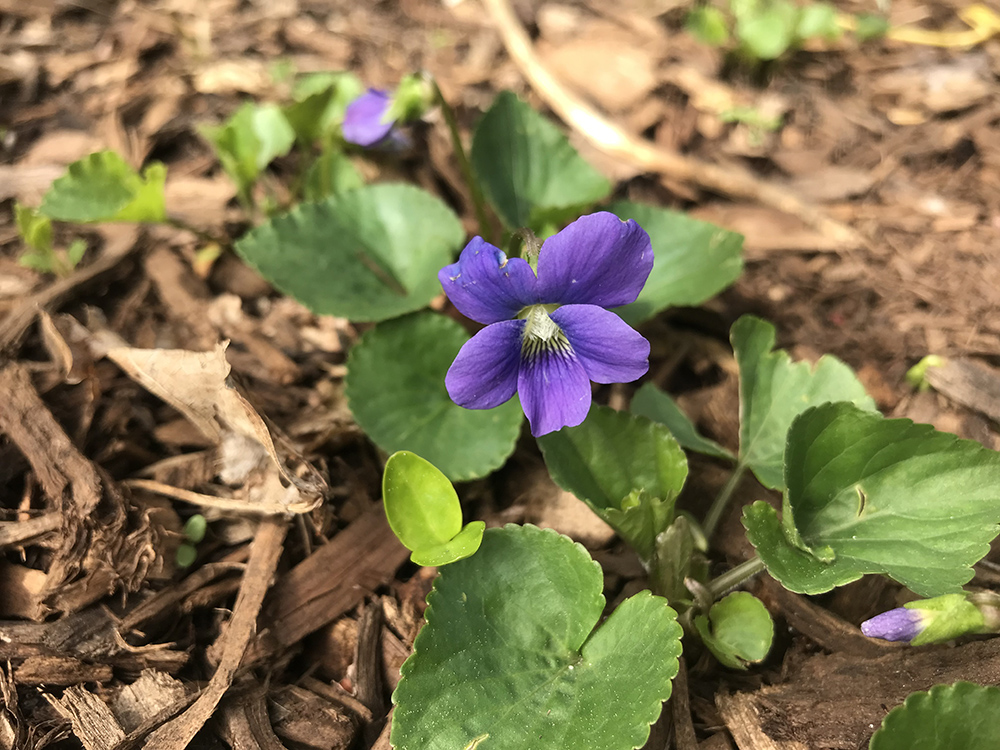Let It Grow
By Tammy Thornton
From early spring until early summer you can easily spot the cute little blue-purple flowers and heart-shaped leaves of our New Jersey State Flower, the Common Blue Violet (Viola sororia). Adopted as the state flower of New Jersey in 1971 at the urging of garden clubs, this native of the Eastern United States also has bragging rights as the state flower of Illinois, Wisconsin, and Rhode Island.
Found along streams and woodlands (or quickly filling your lawn), their cheery little faces thrive in part shade and enjoy the cool weather of spring. Violets are not heat-tolerant though and will begin to fade as summer approaches, possibly making a cameo appearance again in the fall.
These native, deer-resistant perennials can be used as a low-maintenance ground cover and will quickly spread in a variety of ways. Violets spread by underground rhizomes, but if they grow too invasive, they are easy to dig up. Just be sure to remove all traces of the rhizomes or they will grow back. They also reproduce by freely self-seeding, making them aggressive growers.
Now the fascinating part. Violets grow two different types of flowers. Most of the flowers that we adore in the garden are the open showy flowers that attract pollinators. These are called chasmogamous flowers (from the Greek for “open marriage”). They reproduce mainly through cross-pollination by insects or the wind carrying the pollen. Violets have these types of flowers, but they also form another type of flower called cleistogamous (or “closed-marriage”). These form later in the season. The flowers remain closed and are able to self-pollinate. Violets have the unique trait of forming both “open-marriage” and “closed-marriage” flowers on the same plant. If violets had a social media page, their relationship status would be “it’s complicated”.
Both types of flowers have advantages and disadvantages. Cleistogamous flowers are fertile and have the advantage of not relying on pollinators to reproduce. They self-pollinate within the closed flower. These types of flowers can also allow the plant to conserve the energy that it would have spent on producing showy, nectar-laden chasmogamous flowers. Cleistogamous flowers can allow the plant to reproduce despite adverse environmental conditions. On the other hand, cleistogamous flowers are basically producing a clone of the parent plant, whereas chasmogamous flowers can cross-pollinate and produce genetically diverse plants. Having both types of flowers on one plant allows violets to maintain genetic diversity, but also enables them to reproduce by self-pollination when environmental conditions are unfavorable. This little “common” blue violet doesn’t seem so common after all.
Because of their ability to reproduce and spread, some gardeners may consider violets weeds. But another reason you may consider allowing them to grow in your garden is that they are the host plant for fritillary butterfly caterpillars. These fritillaries are broken into two groups, greater and smaller. Violets are the sole host plant for greater fritillary butterfly caterpillars. But they are difficult to spot since they feed at night and hide away from the violet during the day.
Violets are also edible and contain high amounts of vitamin A and C. The leaves and flowers can be used in salads or as a garnish. Imagine a spring cake decorated with purple violets. Of course, make sure that any flowers you intend to consume have not been treated with chemicals or pesticides. Allow the plant to bloom to properly identify the violet before eating its leaves.
When I think of violets, I am reminded of the story my mother-in-law would tell us. Her father, Arthur, was quite the gardener, and her mother’s name was Viola. He created a path of violets for the family to walk through and called it Viola Way. What a romantic!
Though our state flower may be called common, the mighty little violet has beauty and steadfastness. It is a necessity for the fritillary butterfly and has a unique way of reproducing with different types of flowers. If that isn’t enough, you can eat it or use it to decorate. I call that uncommonly good.
Tammy Thornton is a mom of four, a substitute teacher, and a Sunday school teacher. She is passionate about gardening and cooking, and loves the beach.






